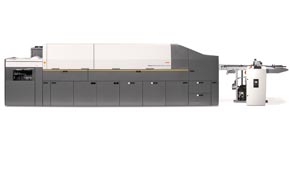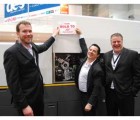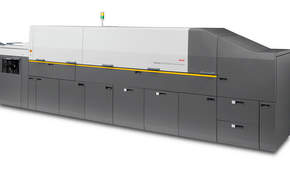
If the ‘noughties’ will be remembered for the unparalleled levels of consolidation in the printing industry, the 2010s will go down in history as the period where strategic alliances came to the fore. The past couple of years have seen a number of former manufacturing foes coming together to leverage their combined expertise and resuscitate flagging equipment sales.
These partnerships have enjoyed mixed results globally, but one that appears to have worked particularly well is the tie-up between Konica Minolta and Kodak, which allows the former to sell the latter’s NexPress devices on an exclusive basis in Australia.
The alliance, announced at PacPrint 2009, was further strengthened earlier this year when the two parties revealed they had expanded their global distribution deal to allow them to sell products from their combined production digital portfolio in different territories.
It’s a deal that has benefited both companies, says Konica Minolta general manager of production printing David Procter – especially in the past year.
“The opportunities for the NexPress have increased significantly over the past nine months locally and Konica Minolta globally has seen the benefits of this relationship and partnering with Kodak both in Europe and the US,” he says.
He sees this relationship strengthening further in the future thanks to the worldwide launch of the Kodak NexPress SX in the fourth quarter of 2010. The release is an upgrade to the existing NexPress SE. Shipping of the SX model to customers in Australia and New Zealand commences in July. But the vendor has already completed a number of new installations of the SE with these users offered an automatic upgrade to the SX as soon as it becomes available.
The NexPress was first introduced back in 2001 as the result of a joint venture between Heidelberg and Kodak. It was a match made in heaven – the German giant brought its engineering expertise to the table, with Kodak throwing its imaging technology and software into the mix. However, three years later, the Heidelberg sold its share of the business to Kodak as part of a strategic business decision to exit digital.
The NexPress range has since undergone a number of upgrades but the fundamentals remain the same. This is an incredibly robust digital printing press capable of a monthly duty cycle of up to 4.4 million A4 impressions. But unlike a lot of workhorses, the NexPress offers high-quality results that “close the gap between digital and offset printing capabilities”, claims Kodak. It’s also an incredibly versatile device capable of handling a wide range of substrates for a wide range of applications encompassing direct mail, marketing collateral, trans-promo and photographic reproduction.
The new SX platform builds on the device’s existing strengths and is backward-compatible to NexPress machines from 2005 to present day, says Steve Ford, sales and strategic product groups director at Kodak Australasia. A key difference from the SX and previous incarnations is the new machine’s ability to handle a bigger sheet size through an optional long sheet feeder.
“The long sheet feeder extends the paper size up to 660mm, allowing printing of 6pp brochures or 3-up A4/letters,” explains Ford. “It was introduced to meet a growing market need for a more cost effective way to produce 3-up A4 work – gatefolds, presentation folders, book jackets and covers – together with commercial work such as business cards. The longer sheet enables the printer to produce more impressions on a sheet, which lowers the cost of production.”
A further change is the fifth imaging unit, which adds a red, green or blue dry ink for “more accurate reproduction of Pantone colours or other custom colours in brand elements as well as better reproduction of previously difficult to match wide gamut colours”, says Ford.
In addition to these dry inks, a number of speciality colour applications are also available for greater value-add. These include a clear dry ink, for inline watermarking, spot or flood coating; a dimensional clear ink that gives specific text and/or images a raised/3D effect; a red fluorescing clear ink that is virtually invisible to the naked eye but fluoresces red when illuminated with UV light; and a light black ink that produces “outstand-ing photo-quality results comparable to other technologies that may require up to three additional colours”, claims Ford.
“With the addition of these high-impact visual, tactile and added security capabilities, digital print can become even more relevant – and more profitable – than ever before,” he adds.
Another key attraction of the SX is the addition of Kodak’s proprietary Print Genius image processing technology. This is a “unique suite of materials, features and technology that helps manage and maintain peak quality throughout the production run, including Kodak NexPress Intelligent Calibration System, which automates the process of checking and maintaining print uniformity”.
But perhaps the greatest attraction of the SX, particularly to SE users, is the ability to upgrade an existing machine to the new specification. “Kodak is rather unique in that we offer upgrades to our platforms rather than make the machine a redundant investment,” says Ford.
“Users can grow their business and expand on their press capabilities with new features and accessories when application needs change. As customer’s business grows so too can their press. Offering this type of capability future proof’s a customer’s investment.”
That’s not to say Kodak and KM are only targeting existing users that might want an upgrade. It also plans to use the SX’s capabilities to hook new users.
In terms of its pricing strategy, Kodak refuses to be drawn on specifics beyond stating the SX is “competitively priced in the local market”. It’s equally reluctant to reveal the exact number of installs or orders, although Ford does say “its impact in the local market is growing steadily in both install base, appeal and reputation. Our strategic relationship with Konica Minolta is yielding increased market growth across Australia.
“Kodak is experiencing growing demand and interest for the NexPress platform. 2011 has already been a busy year with a number of well-publicised sales of the NexPress SE platform into the Australian market. We expect to continue this trend throughout 2011 and beyond.”
Konica Minolta’s Procter also refuses to divulge specific sales figures, although he’s equally bullish about the machine’s future prospects with the continued development of the NexPress “providing us with some strong advantages against its competition”.
As does the company’s growing number of alliances, he argues. “Partnering with Kodak and Heidelberg at PrintEx in Sydney illustrated the value of strong alliances and what can be achieved when we all work together,” says Procter.
The fact that the NexPress is still an incredibly popular machine a decade after its launch says a lot about the build quality and technology that Heidelberg and Kodak brought to the table. But perhaps one of its greatest strengths, which has been further enhanced thanks to the global economic meltdown, is Kodak’s canny tactic of allowing users to continually upgrade their machines to the latest technology.
The world of digital print is changing at a rate of knots, but NexPress customers can sleep safe in the knowledge that they can take advantage of any new features and capabilities that the manufacturer introduces, while retaining their original capital investment. And in the current financial climate, that’s a major draw indeed.
Specifications
Monthly duty cycle: Up to 4.4m A4 impressions
Max speed: 131 A4ppm
Max sheet size: 356x660mm
Paper weight: 80-350gsm (coated)
Footprint: 6,036×2,045×1,769mm
Weight: 3,873kg
Contact: Konica Minolta (02) 8026 2222 david.procter@konicaminolta.com.au
Kodak (03) 8417 8000 www.graphics.kodak.com/AU/en
The Alternatives
HP Indigo 7000
The flagship model in the Indigo range is a highly productive machine, with a headline speed of 120 A4 ppm – 76% faster than its predecessor, the Indigo 5500. The SmartStream Production Pro IN100 front-end can handle photobook applications with different images on each page at the press’ rated speed. Like the iGen4, the 7000 can easily handle average monthly page volumes of 3.5m.
Max speed: 120 A4ppm
Max sheet size: 330x482mm
Contact Currie Group: (03) 9810 1331 enquiries@curriegroup.com.au
Xerox iGen4
With the launch of the iGen4, Xerox claims to have increased productivity by 25-35% over its predecessor, the iGen3, by improving the machine’s uptime. Hardly revolutionary, but this workhorse-like device, which has an average monthly duty cycle of 3.5m, has an impressive top speed of 110 A4ppm and features an X-Rite spectrophotometer as standard to enable automated measurement and control of colour.
Max speed: 110 A4ppm
Max sheet size: 364x521mm
Contact: Fuji Xerox 131 412 www.fujixerox.com.au
Fuji Xerox Color 1000
While it’s a step down in terms of speed, this digital device has been winning over customers with production-level capabilities at a lower entry price. Notably, it rivals one of the NexPress’ key selling points though it use of EA-Eco toner to offers “advanced image quality”, and Clear TonerNote 1 for special applications such as watermarking. Capable of a top speed of 100ppm, the press can handle a wide range of paper grades spanning 55-350gsm.
Max speed: 100ppm
Max sheet size: 330x488mm
Contact: Fuji Xerox 131 412 www.fujixerox.com.au
Comment below to have your say on this story.
If you have a news story or tip-off, get in touch at editorial@sprinter.com.au.
Sign up to the Sprinter newsletter


